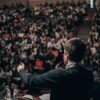It is a truism in higher education, especially at liberal-arts institutions, that interdisciplinary collaboration promotes academic excellence—that it forms well-rounded students and fosters communities of intellectual creativity.
We want our students to combine ideas from multiple disciplines in order to be critical and flexible thinkers. They should study philosophy and literature so that they can understand nuanced arguments and appreciate the structure of a sentence or a story. They should study art history so that they can perceive the composition of a painting and global history so that they can explain how the world came to be the way it is. They should study theology so that they can ask questions about who God is and study the Bible so that they can better interpret it.
While we present our students with a diverse slate of courses, we faculty are often pushed by our disciplinary training in graduate school and the pressure to publish toward narrow specialization.
Specialization, however, hinders successful communication between and among faculty and students as well as with the wider communities to which we belong.
Let me offer a case study: the word “modern.” What does this word mean? I polled some colleagues, students, and non-academic friends recently, asking them to use the word “modern” in a sentence. Their answers were instructive.
A former student of mine, now getting her PhD in English literature, understands by “modern” an era that starts around the time of Shakespeare: “What was formerly referred to as ‘the Renaissance,’ many scholars today refer to as ‘the Early Modern’ era.” I tend to think about the word “modern” this way too. A humanities course that I teach, covering the era from the Protestant Reformation to the Enlightenment, is called “Enduring Questions: The Early Modern World.” I have to spend some time convincing my students that Martin Luther and John Calvin are “modern” in this sense.
But an English professor friend used the word “modern” to define the literary era between World Wars I and II: “Teaching a class on modern American literature involves defining American modernism as the period roughly between the two world wars.”
A recent graduate of the visual-arts program at my institution also defined “modern,” implicitly, in terms of twentieth-century artistic movements. She wrote, “Modern art philosophies continue to influence contemporary artists who fight against the status quo.” And the wife of a colleague in our physics department quoted her husband to me: “Modern Physics is really what happened in the last 100 years.”
Recently in the Christian Scholars Review blog, Katie Kressler used the word similarly to how I use it in my humanities course when she wrote that “the age right before ours, the ‘modern,’ is widely marked by the following characteristics . . . .” But then she added an “ism” like my fellow literature professor: “the characteristics above illustrate just one cross-section of the very complex phenomenon we call modernism.”1
I too tell my students that the “modern era” starts with the Reformation and continues up to the present but that “modernism” refers to the literary style of figures like James Joyce and T.S. Eliot. But to complicate things further, I use the word “modernity” to refer to the culture that emerged late in the modern era: the industrialized societies of the nineteenth and twentieth centuries.
Finally, there’s the term “postmodern” (with or without a hyphen). Are we in a post-modern era now because the modern era is over? Does “postmodern” refer to a philosophical stance rejecting values that were important in the modern era? A pastor friend offered this sentence: “The tv show Modern Family is, ironically, about an essentially postmodern family.” Like “modernism,” however, “postmodern” can also refer to a set of experimental and self-referential literary works, a playful and eclectic architectural style, or a twentieth century art movement. I might contribute the following use of “postmodern” in a sentence: “my favorite postmodern sculpture, Balloon Dog by Jeff Koons, was accidentally shattered recently.”
Moreover, all of this is, literally, academic when we consider how most people use the word “modern.” My non-academic friends wrote things like: “I’m planning on renovating my kitchen to have a more modern feel” or “My wardrobe is no longer working for me. I think I will update to a more modern look.” In those cases, modern means the most recent or up-to-date. But two of my friends referred to the architectural/design style of “mid-century modern,” which has connections to the more academic meaning of artistic and literary movements of the mid-twentieth century.
What are we to do with all of these definitions produced by these specialized uses?
My rather simple answer is that we academics need to go back to school. We need to sit in on the classes of our colleagues. We need to teach with each other. We need to listen well and tune into how other people are using language differently from the way our own scholarly tribe does.
When we learn from each other, when we are not so locked into our own jargon and can converse with others across the quad or even off campus, we become better and more flexible thinkers. It might even allow us to work on bigger and more complex problems that demand translation and collaboration. We can learn to do the things we say we’re teaching our students to do.
While I would recommend cross-disciplinary learning for all academics, this recommendation is particularly apt for Christian scholars. Followers of Jesus belong to a wider community of faith who share the common task of contributing toward the fulfillment of his kingdom. We have an extra reason to not isolate ourselves within narrow guilds. We have grounds for flexible thinking and problem-solving for the work of the kingdom that members of our secular disciplines do not share.
Yet I don’t wish to minimize the pleasures of scholarly expertise and shared jargon. I only want to suggest that we learn to converse with others beyond our guilds.
I’ve been thinking recently about these pleasures and their limitations. I teach a class in the history of literary theory; we always spend a period talking about “deconstruction”: a short-lived methodological trend inspired by the cryptic writings of twentieth-century philosopher Jacques Derrida.2 When I was in college and graduate school in the 1990s, it seemed like everyone was talking about deconstruction. It came and went as a critical methodology and isn’t used much anymore. But I was recently in a Zoom poetry discussion sponsored by Comment magazine and the discussion leader used the phrase “surplus of meaning,” a catch-phrase of deconstructionists. I smiled knowingly. Aha! A member of my guild. This moment of shared knowledge and shared vocabulary was pleasant. I felt connected to a fellow member of a shared scholarly community. It was like a secret handshake.
But the pleasure was limited and that specialized knowledge is not all that useful. My students have never heard of Jacques Derrida or the philosophy or literary critical methodology of deconstruction. However, some of them from evangelical Christian contexts have now heard about “deconstruction” in a new sense: referring to a process of critically reexamining one’s faith commitments. I hadn’t heard the word used in that sense until recently.
Still, maybe I’m misunderstanding the new usage. I’d better talk to my pastor or swing over to the office of a colleague in theology and ask how he would define the word. Or maybe I can sign up for his course, “Christianity, Postmodernism and Beyond,” next semester. I might learn something.
Footnotes
- Kresser, Katie. “Singing Stones.” Christian Scholars Review Blog. March 3, 2023. https://christianscholars.com/singing-stones/
- See e.g. Derrida, Jacques. Writing and Difference. Translated by Alan Bass. Chicago: University of Chicago Press, 1978.























